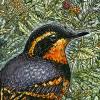

Join BirdNote tomorrow, November 30th!
Illustrator David Sibley and actor H. Jon Benjamin will face off in the bird illustration battle of the century during BirdNote's Year-end Celebration and Auction!
How long can a bird fly without touching the earth? To find out, Swiss scientists attached sensors to Alpine Swifts. The sensors showed long periods when the swifts were gliding and not flapping their wings. Were the birds asleep? Scientists don’t know for sure. It could be that Alpine Swifts sleep during the summer breeding season — and don’t sleep at all during migration. But why do they stay aloft so long? Swifts can’t perch because they have very short legs. So if they can manage it, avoiding touching down makes perfect sense.
BirdNote gives you the sounds of birds every day, and you can get the sights as well when you follow us on Instagram, at BirdNote radio. / @BirdNoteRadio
BirdNote®
Alpine Swifts Fly Non-Stop
Written by Bob Sundstrom
This is BirdNote.
How long can a bird fly without once touching the earth or alighting to perch?
[Alpine Swifts calling, http://www.xeno-canto.org/species/Tachymarptis-melba]
Experts have speculated for years that some kinds of swifts spend long, continuous periods of their lives in the air. To figure out exactly what they get up to, Swiss scientists began researching Alpine Swifts — a large species with a wing-span of over two feet. The research published in 2013 involved attaching sensors to some of the swifts while they were nesting in Europe, and recovering them on the birds’ return from spending winter in Africa.
[Alpine Swifts calling]
It was already known that the swifts eat on the wing. But what about sleep? The sensors showed long periods when the swifts were gliding and not flapping their wings. But scientists aren’t sure if that means the birds were asleep. It could be that, like some other animals, Alpine Swifts do all their sleeping during the summer breeding season. And don’t sleep at all during migration.
As for why they stay aloft so long — while they’re supreme fliers, swifts find landing complicated. They can’t perch because they have very short legs. So if they can manage it, avoiding touching down makes perfect sense.
For BirdNote I’m Michael Stein.
BirdNote gives you the sounds of birds every day, and you can get the sights as well when you follow us on Instagram, at BirdNote radio. / @BirdNoteRadio
###
Bird sounds provided by The Macaulay Library of Natural Sounds at the Cornell Lab of Ornithology, Ithaca, New York. Alpine Swifts [XC283739] recorded by Jordi Calvet at Esparreguera, Catalonia.
BirdNote’s theme music was composed and played by Nancy Rumbel and John Kessler.
Producer: John Kessler
Executive Producer: Dominic Black
© 2016 Tune In to Nature.org January 2016 / 2018 / 2022 Narrator: Michael Stein
ID# ALSW-01-2016-01-20ALSW-01





